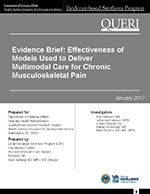
Investigators: Kim Peterson, MS; Johanna Anderson, MPH; Donald Bourne, BS; Katherine Mackey, MD; Mark Helfand, MD, MS, MPH
Download PDF: Brief, Supplemental Materials
In Veterans, chronic pain may occur in up to 50% of those treated in primary care, and severe pain is more prevalent than in the general population. Chronic pain is a major public health challenge that is associated with serious physical and psychosocial impairment which costs the United States approximately $635 billion annually. Pain is a complex condition involving dynamic interactions between biological, psychological, and social factors unique to each individual. For this reason, pain care needs to be individually tailored, involving multiple care approaches and collaboration between primary and specialty care clinicians. Pain management guidelines, including those for the VHA, advocate for multimodal pain care. The VHA National Pain Management Strategy utilizes a stepped care model of pain management involving primary care and patient aligned care teams (PACTs), secondary consultation, and tertiary interdisciplinary pain centers. However, barriers to effective implementation of guideline-concordant care still exist, including: limitations in service accessibility; provider time constraints leading to fragmentation of the care process; complexity of treatment decisions due to variability in patients' pain characteristics and multimorbidities; variability in patient education, activation, expectations, suspicion, and mistrust; provider training and burnout; and reimbursement limitations. Thus, there is a need to identify effective models of chronic pain care with system-based interventions aiming to improve the delivery of multimodal care.
Our objectives were to determine what multimodal care delivery models relieve chronic musculoskeletal pain and minimize unintended consequences, define key elements of and the resources required for these models, and identify patients who are most likely to benefit from these models.
Effectiveness of Models Used to Deliver Multimodal Care for Chronic Musculoskeletal Pain (Management eBrief)
Peterson K, Anderson J, Bourne D, Mackey K, and Helfand M. Effectiveness of Models Used to Deliver Multimodal Care for Chronic Musculoskeletal Pain: A Rapid Evidence Review. Journal of General Internal Medicine. Published online April 11, 2018. https://doi.org/10.1007/s11606.